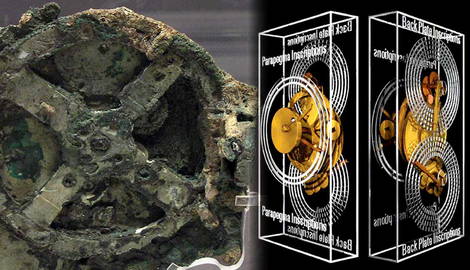
Since its discovery in 1901 off the coast of the Greek island of Antikythera, the Antikythera Mechanism has fascinated scholars in many fields. Studies of the inscriptions on the mechanism and reconstructions of its gears have established that it was an astronomical calculator. It has gears for telling time and predicting eclipses and planetary positions. The Antikythera Mechanism reveals that mechanical technology in the Hellenistic period was much more advanced than previously thought, rivaling early modern Western Europe. It also reveals how astronomical knowledge was integrated into everyday life.
The Discovery of the Antikythera Mechanism

In 1901, Greek sponge divers off the coast of the island of Antikythera discovered a shipwreck filled with ancient artifacts, which were later revealed to be from the Hellenistic Period, circa 100 BCE. After their discovery was announced, the artifacts were taken to the National Archaeological Museum in Athens.
One of the artifacts was a peculiar work of artifice, which did not generate much interest until a few months later when it broke into pieces and revealed a system of circular gears. It was long suspected to be an astronomical calculator of some sort (Price 1974; Wright 2005), but significant progress was made in interpreting the purpose of the Antikythera Mechanism in the 2000s when high-tech imaging techniques were used to decipher the inscriptions on the individual gears and accurately reconstruct the gear structure using X-ray images (Freeth et al. 2006).
By 2005, it was confirmed that one of the back gears was used to predict eclipses. By 2008, it was determined that one of the subsidiary back gears was related to calculating the Olympiad, a time-period of four years based on the ancient Olympic Games. It is now known that the Antikythera Mechanism incorporates numerous cycles known to the ancient Greeks that were important for their civil calendars, including the Metonic lunar phase cycle and the Saros eclipse cycle. More recent studies have provided evidence that it also functioned as a planetarium and could predict the motion of the planets visible in antiquity: Mercury, Venus, Mars, Jupiter, and Saturn. This has led to a significant advancement in understanding the purpose of the Antikythera Mechanism and what it reveals about the astronomical knowledge and mechanical capabilities of Hellenistic civilization around 100 BCE.
Structure of the Back of the Antikythera Mechanism

The Antikythera Mechanism is a rectangular-shaped mechanism that was probably contained in a wooden box (Price 1974). It contains a front section and a back section, each with unique gears with inscriptions. The back section has two large dials with three subsidiary dials. The large upper back dial has been shown to reflect the Metonic cycle, based on inscriptions (Wright 2005; Freeth et al. 2006). The Metonic cycle is a 19-year, or 235-month, lunar phase cycle in which a lunar phase will occur on the same date in the year about every 19 years. The Metonic cycle would have been important for managing the lunar-based calendars used by ancient Greek cities because there was a need to adjust the lunar calendar to keep it synced with the seasons.
Within the large upper back dial are also two smaller dials. One has been shown to be related to calculating the Olympiad. The Olympic Games occurred every four years and were important for social, religious, and chronological purposes. This dial is divided into four parts and each part is labelled according to intermediate games that happened between the Olympic Games (Freeth et al. 2008). Although not completely preserved, there is evidence of another subsidiary dial within the Metonic dial that recorded the 76-year Callippic cycle (Freeth et al. 2008). The Callippic cycle was incorporated to make the Metonic-based lunar calendar more accurate. Since the 235 months of the Metonic cycle do not equal exactly 19 years, the Metonic cycle time-period was multiplied by four to create a whole number period of days 76 years long, which is called the Callippic cycle.
The lower large dial has been shown, based on inscriptions, to be related to the 223 months Saros cycle (Freeth et al., 2008; Freeth, 2014). The Saros cycle predicts that an eclipse, lunar or solar, will be followed by an almost identical eclipse 223 months later due to an almost identical configuration of the sun, the moon, and Earth.
Structure of the Front of the Antikythera Mechanism

The front of the Antikythera Mechanism consists of a single large dial upon which a large network of complex gears was originally attached. Analysis of inscriptions and digital reconstructions suggests that the gears were used to predict the motion of the sun, moon, and five classical planets visible in antiquity, Mercury, Venus, Mars, Jupiter, and Saturn (Freeth et al. 2021).
The movements of the mechanical gears were based on the geocentric cosmology that was favoured by most ancient Greek astronomers. In this model, the earth is at the center of the universe and the sun, moon, and planets orbit the earth. One of the major mysteries of ancient astronomy was the retrograde motion of Mars. Because Mars is farther from the sun than Earth, and Earth orbits the sun faster than Mars, the Earth overtakes Mars as they circle the sun. As a result, from the perspective of an observer on Earth, Mars appears to backtrack in its path over the course of the year before resuming a forward course. This is very hard to explain in the geocentric model.
Ancient Greek astronomers tried to explain this by arguing that the planets orbited the earth in a great circle while also moving in smaller circles, or epicycles, as they circled the earth, which could explain the retrograde motion of Mars. This cosmological model is believed to be used for organizing the gears so that the planets, the sun, and the moon follow motions expected by this epicyclic model (Freeth et al. 2021). In this way, the front dial appears to represent a model of the ancient Greek cosmos, while the back dial appears to be for telling time. Both parts of the Antikythera Mechanism worked together to allow observers to predict the motion of the celestial bodies and to predict astronomical events like eclipses, making it essentially a mechanical planetarium.
Background and Purpose of the Antikythera Mechanism

The shipwreck in which the Antikythera Mechanism was found dates to about 100 BCE (Freeth et al. 2006), placing it in the middle of the Hellenistic Period. The names of the months used on the Metonic calendar dial suggest an origin in the Corinthian colonies, which would have included Syracuse. This suggests a connection to the Greek inventor Archimedes, who died in 212 BCE in the Roman attack on Syracuse (Freeth et al. 2008). Interestingly, the Roman orator Cicero talks about a mechanical planetarium designed by Archimedes (Freeth et al. 2008). While it can never be known with certainty, this does make it plausible that the Antikythera Mechanism may have been a copy of the one invented by Archimedes.
Another clue to its historical context is that the month names on the calendar are common month names associated with a specific civil calendar rather than technical names used by astronomers (Freeth et al. 2008). This suggests that the Antikythera Mechanism may have been used for civil purposes and not just as a scientific instrument. This has implications for the degree to which scientific and technological knowledge was integrated into Hellenistic society.
Historical implications of the Antikythera Mechanism

The Antikythera Mechanism, using complex mechanical workings combined with astronomical knowledge to make predictions about the motion of the planets, suggests that Hellenistic technology was surprisingly advanced. Devices comparable to the Antikythera Mechanism in terms of mechanical sophistication do not appear again until the early modern period (Freeth et al. 2021). Technological devices, such as the Antikythera Mechanism, reveal evidence of accelerating technological progress through the Hellenistic Period. This adds to the mystery of why Hellenistic science and technology did not continue to advance and why there was no industrial revolution in the eastern Mediterranean around the time of Christ.

It is notable that analogous technical artifacts are rare in the Hellenistic world and are usually only found in connection with specific inventors who may have been more interested in using their inventions to advance their scientific investigations than applying the technology to solve practical problems in society. The possible use of the Antikythera Mechanism to regulate the civil calendar in the Corinthian colonies could represent an exception to that rule.
References
Freeth, T., Bitsakis, Y., Moussas, X., Seiradakis, J. H., Tselikas, A., Mangou, H., … & Edmunds, M. G. (2006). Decoding the ancient Greek astronomical calculator known as the Antikythera Mechanism. Nature, 444(7119), 587-591.
Freeth, T., Jones, A., Steele, J. M., & Bitsakis, Y. (2008). Calendars with Olympiad display and eclipse prediction on the Antikythera Mechanism. Nature, 454(7204), 614-617.
Freeth, T. (2014). Eclipse prediction on the ancient Greek astronomical calculating machine known as the Antikythera Mechanism. Plos One, 9(7), e103275.
Freeth, T., Higgon, D., Dacanalis, A., MacDonald, L., Georgakopoulou, M., & Wojcik, A. (2021). A Model of the Cosmos in the ancient Greek Antikythera Mechanism. Scientific reports, 11(1), 5821.
Price, D. (1974). Gears from the Greeks. The Antikythera mechanism: a calendar computer from ca. 80 BC. Transactions of the American Philosophical Society, 1-70.
Wright, M. T. (2005). The Antikythera mechanism: a new gearing scheme. Bulletin of the Scientific Instrument Society, 85, 2-7.








